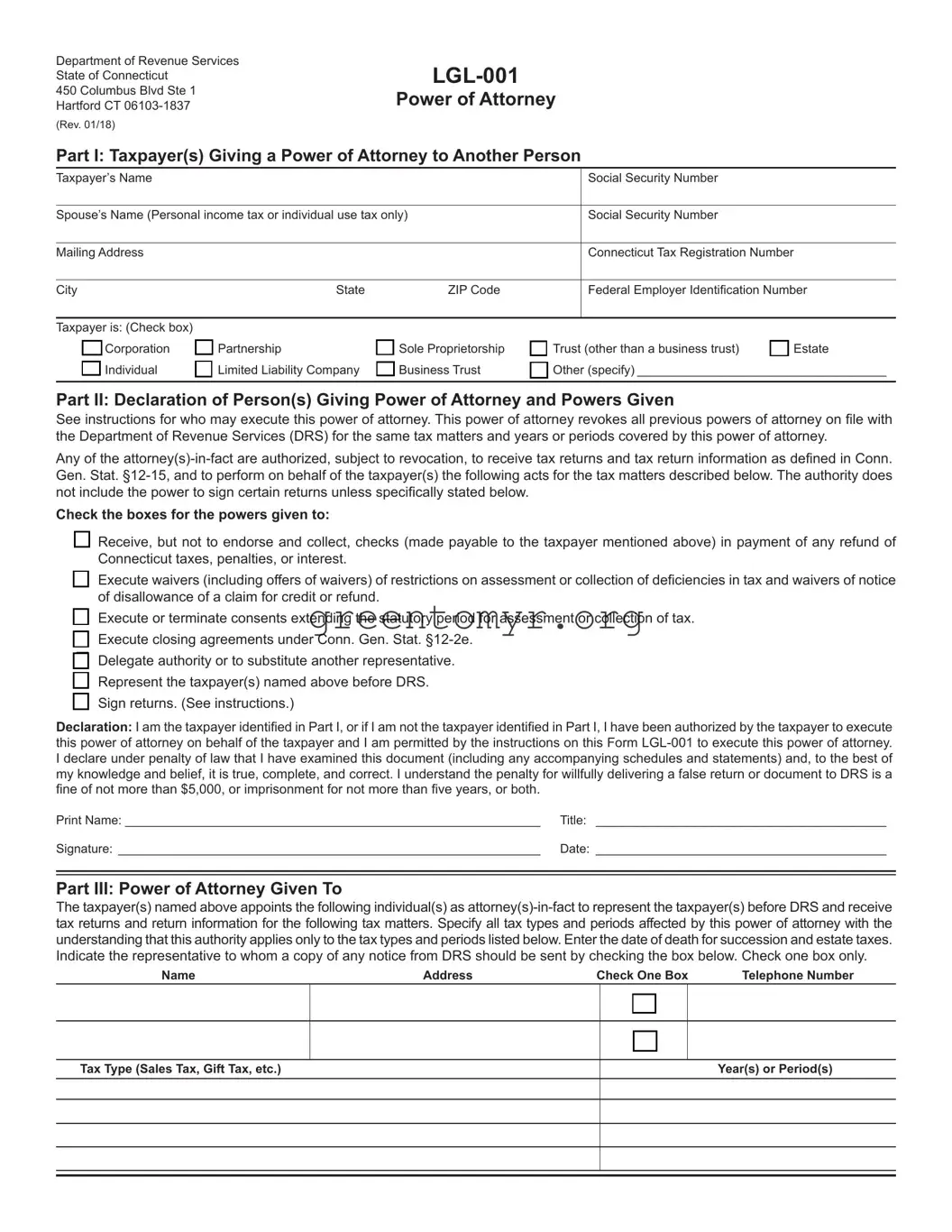Use LGL-001, Power of Attorney, to authorize one or more individuals to represent you before DRS. This authorization allows your representative(s) to receive and inspect confidential tax information and to act on your behalf in matters before DRS.
Connecticut law stipulates that all official mailings will be sent to the taxpayer of record at the address on file with DRS. As a matter of policy, DRS also provides taxpayers with the right to have a copy of any notice sent to its counsel or other qualified representative who has properly executed and filed this power of attorney with DRS for the type of tax and tax period that is the subject of the notice. This power of attorney does not change the requirement that DRS send all official mailings directly to the taxpayer.
Part I: Taxpayer(s) Giving a Power of Attorney to Another Person
Provide the taxpayer’s name and address and either your Social Security Number (SSN) or Connecticut Tax Registration Number and Federal Employer Identification Number. If you are a sole proprietor, enter your name and SSN. Do not enter your trade name. Do not use your representative’s address as your own.
Your spouse’s name is not required except for joint personal income tax or individual use tax returns.
If you are filing a joint personal income tax return and you and your spouse have the same representative(s), include your spouse’s name and SSN in the space provided. Otherwise, each spouse must file a separate LGL-001.
Check the box that describes the taxpayer.
Part II: Declaration of the Person Giving Power of Attorney And Powers Given
Any person giving a power of attorney to another person(s) must sign this declaration and must check the box for each act being granted to the attorney-in-fact to perform in matters before DRS. If a tax matter concerns a joint return, both husband and wife must sign in the space provided if they wish to be represented by the same person(s).
Who may execute this power of attorney?
Any individual if the request is for an income tax return filed by that individual (or filed by that individual and his or her spouse if the request is for a joint income tax return);
Conn. Agencies Regs. §12-725-1(b) allows an agent, or a fiduciary charged with the care of the person or property of the taxpayer, to make and sign a return only when illness, absence, minority, or other good cause prevents the person required or permitted to make or file a Connecticut income tax return from doing so. You must state a reason why the taxpayer cannot sign the return.
A limited liability company (LLC) member if the taxpayer is an LLC and has no manager or a manager if the taxpayer is an LLC and has managers
The sole proprietor if the taxpayer is a sole proprietorship;
A general partner if the taxpayer is a partnership or a limited partnership;
The administrator or executor if the taxpayer is an estate;
The trustee if the taxpayer is a trust;
If the taxpayer is a corporation, a principal officer or corporate officer (who has legal authority to bind the corporation), any
person who is designated by the board of directors or other governing body of the corporation, any officer or employee of the corporation upon written request signed by a principal officer of the corporation and attested to by the secretary or other officer of the corporation, or any other person who is authorized to receive or inspect the corporation’s return or return information under I.R.C. §6103(e)(1)(D);
The successor, receiver, guarantor, or any assignee of the taxpayer; or
The authorized representative of any of the above.
Part III: Power of Attorney Given To
Provide the name, address, and telephone number of the person(s) designated by you to be your attorney(s)-in-fact. If you are adding additional representatives to an existing power of attorney, include the names of all individuals you wish to represent you. This power of attorney revokes all previous powers of attorney on file with DRS for the same tax matters and years or periods covered by this power of attorney.
Enter the tax type and the tax periods or tax years that are the subject of this power of attorney. Be specific about the type of tax at issue (refer to the following examples):
Withholding tax;
Income tax;
Sales and use taxes;
Corporation business tax;
Admissions and dues tax;
Estate tax;
Gift tax;
Motor vehicle fuels tax;
Gross earnings tax (petroleum, gas, hospital, community antenna);
Cigarette tax distributor; and
Individual use tax.
The terms years and periods can indicate various time frames.
A tax year may be a calendar year of 1/1/06 through 12/31/06 or a fiscal year of 7/1/06 through 6/30/07 for corporation tax. A tax period may have one or more monthly or quarterly periods.
Example: A sales and use tax period of 1/1/04 through 12/31/06 may contain 36 monthly or 12 quarterly periods.
Indicate the tax year(s) or tax period(s) to be covered by the power of attorney.
Where to File
Do not send an LGL-001 to DRS unless you have been in contact with DRS and determined that you would like a third party to represent your interests before the agency.
Mail, fax, or deliver LGL-001 directly to the DRS employee or unit with whom the attorney-in-fact will interact. Consult a DRS representative to find out the name and the address or fax number where the LGL-001 should be directed. To contact DRS, call 1-800-382-9463 (Connecticut calls outside the Greater Hartford calling area only) and select Option 2 from a touch-tone phone, or 860-297-5962 (from anywhere). TTY, TDD, and Text Telephone users only may transmit inquiries anytime by calling 860-297-4911.


